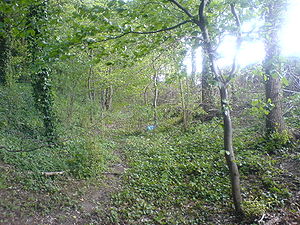
Brent Ditch
Encyclopedia

Cambridgeshire
Cambridgeshire is a county in England, bordering Lincolnshire to the north, Norfolk to the northeast, Suffolk to the east, Essex and Hertfordshire to the south, and Bedfordshire and Northamptonshire to the west...
, England built around the 6th and 7th Centuries . However most of its structure has been lost over time
2 km (~1mile) in length it runs from Pampisford
Pampisford
Pampisford is a village, south of Cambridge, on the A505 road near Sawston, Cambridgeshire, England.Pampisford Hall, the principal house of the village, was rebuilt to the designs of George Goldie for James Binney, whose descendants still live there...
Hall in the North-West to Abington
Abington, Cambridgeshire
The Abingtons are a community in South Cambridgeshire consisting of two villages: Little Abington and Great Abington, south east of Cambridge.-History:...
in the South-East. For most of its length it is wooded and it is on private land and so difficult to access. It was built as a defensive structure to control the flow of trade along ancient routes.
In modern times it is bisected by the routes of the old and new A11. It is from the old single carrageway road (grid reference TL514474) that the structure is best viewed as a low ditch in a wooded area besides the road. The earth works at this point are 2-3M high
The dyke is one of the smaller earthworks of several in south Cambridgeshire designed to control movement along the ancient Roman roads. The others are Devil's Dyke
Devil's Dyke, Cambridgeshire
The Devil's Dyke is an earthwork in the English county of Cambridgeshire. It consists of a long bank and ditch that runs in a south-east direction from the small village of Reach to nearby Woodditton...
, Fleam Dyke
Fleam Dyke
Fleam Dyke is an earthwork in eastern Cambridgeshire, England, generally assumed to be Anglo-Saxon of origin. As a few potsherds of the early and late Bronze age were found in the most eastern part of the dyke it seems that much older earthworks have been used. The archaeologist Prof...
and Bran ditch
Bran ditch
Bran Ditch or Heydon Ditch is generally assumed to be an Anglo-Saxon earthwork in southern Cambridgeshire, England.Most of the ditch has been lost to agriculture over time, but its line its marked throughout by both hedgerow and the route of the Harcomlow Way and Icknield Way paths...
.
Black Ditches, Cavenham
Black Ditches, Cavenham
Black Ditches is an earthwork close to Cavenham, which is generally assumed to be Anglo-Saxon, dating to the 6th or 7th century. It runs south-east from the village for approximately , remaining almost unbroken as a single embankment along its length, reaching a height of almost at points...
is a fifth earthwork guarding the ancient Icknield Way and can be found in Suffolk
Suffolk
Suffolk is a non-metropolitan county of historic origin in East Anglia, England. It has borders with Norfolk to the north, Cambridgeshire to the west and Essex to the south. The North Sea lies to the east...
north west of Bury St Edmunds

